
Image credit: David Allen Burns and Austin Young / Fallen Fruit, ‘Los Angelitos de Nuestra Señora del Jardin,” asynchronous repeat pattern, archival watercolor inks printed on organic fabric, dimensions variable, commissioned by the Vallarta Botanical Garden, Puerto Vallarta, Mexico, 2021.
Interview with Fallen Fruit by Olivia Ann Carye Hallstein
Combining place-based research, fantastical eden-like installation artworks and community activism, the collaborative behind Fallen Fruits has transformed the meaning of what art can do and provide for its audience. These artworks live and grow providing both nourishment for the body and soul by creating public resources that approach topics of displacement, immigration, and legality. All of this held within the colorful, inviting peels of a topic everyone can relate to: fruit! Fallen Fruit is a collaborative art project originally conceived in 2004 by David Burns, Matias Viegener and Austin Young. Since 2013, David Burns and Austin Young have continued the collaborative work. David Burns and Austin Young discuss their international projects, inspirations and process.
Thank you so much for taking the time for this interview! It is absolutely thrilling to speak with you on your work. Let’s start at the beginning: how did the fruits come to fruition?
In 2004, Fallen Fruit began as a response to an open-call for submission for volume three of The Journal of Aesthetics and Protest. The basic question was asked, “is it possible to use the agency of activism, but without opposition?”
We realized our response had to be something we already knew and something we were not paying attention to. We walked our neighborhood of Silverlake in north east Los Angeles, and discovered that over 100 fruit trees were growing in public spaces. Along alleys, sidewalks, and often branches of fruit trees planted on private property were abundantly overhanging fences well into public right-of-way. We mapped these publicly accessible fruit trees and wrote a text that questions who has a right to the fruit from these trees and who has the right to public space. We called the submission “Fallen Fruit” and this began our collaborative work.
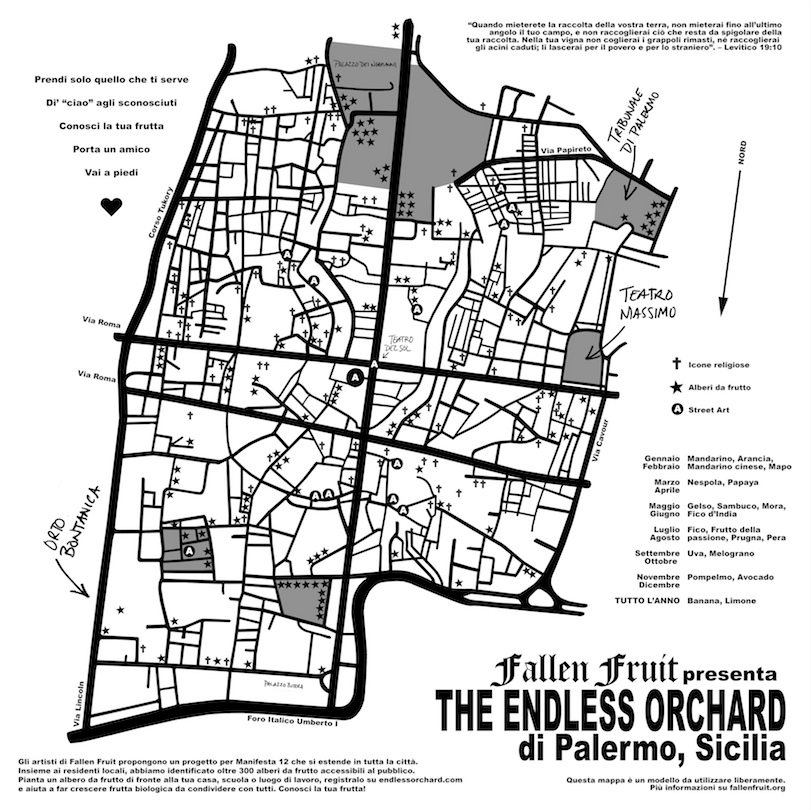
People are so disconnected from each other in Los Angeles - we had the idea this would create social connections. Get out of the car, off the cell phone, and meet neighbors. We also realized we could activate the margins of public space to share resources like fruit bearing trees.
During our interventions, people would tell family histories and stories about fruit. People were excited to connect with their family and cultural rituals, the natural world, and each other. In the end, we created a call to action that could benefit everyone, including the environment, and it does not make anyone wrong.
We have been working on this project for over 17 years now. The project is always collaborative, the artworks are process oriented and research based. We do not have a studio and the work is always site specific. We have a philosophy that what we create is a body of artwork that is living and growing - literally and figuratively.
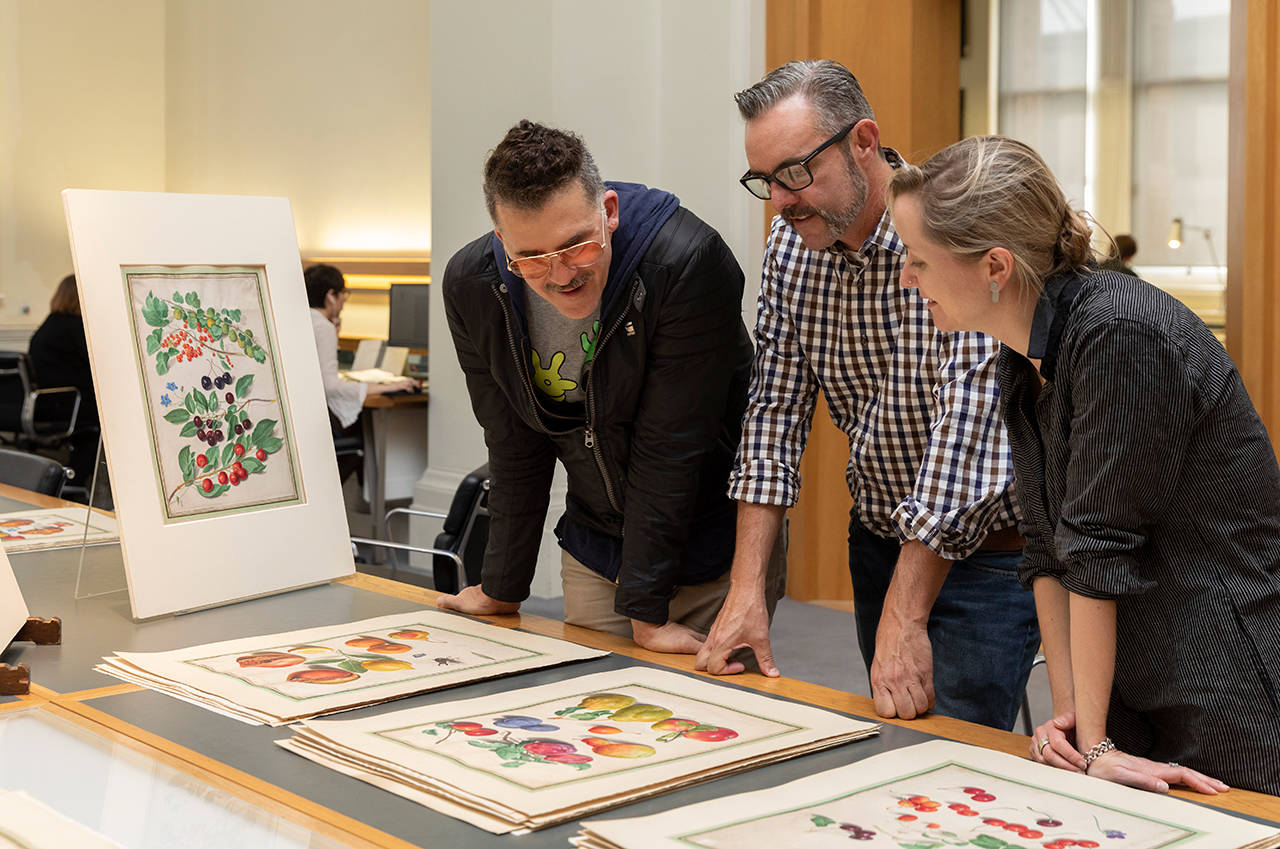
Image credit: Artists David Allen Burns and Austin Young with Curator Catherine Flood researching the V&A's botanical drawings collection. © Victoria and Albert Museum, London, 2019.
It is so exciting to see work that surpasses the limits of the traditional gallery and into an activist space that, as you say, “does not make anyone wrong.” And the title “Fallen Fruit” is so distinctive. What led to this title and how has this title led your collaborative work?
FALLEN FRUIT is from Leviticus. It references an old Roman law:
When you reap the harvest of your land, you shall not reap all the way to the edges of your field, or gather the gleanings of your harvest.
You shall not pick your vineyard bare, or gather the fallen fruit of your vineyard; you shall leave them for the poor and the stranger.
At first, we took this message literally. Drawing maps, walking cities, and thinking about messages of sharing and generosity. We explored the real world in real time and focused on fruit trees growing on the margins of public space in neighborhoods around the world. And everywhere we are invited to make art, we learn deeply about people and places.
…everywhere we are invited to make art, we learn deeply about people and places.
In our current work, we are focused on research based installation artworks. These works are also about place and activate historic collections, original photography, and now uses limits of architecture as the frame. The works explore collective meanings, cultural mythologies, and celebrate geographical locations. Our art and process has expanded in dynamic ways. We are exploring issues of identity, cultural memory, and historical artifacts. We love nuances of collective histories that synthesize concepts in themes of legacy and the public realm.
For example, we have discovered that history is often bi-located, meaning that what is written and told as the historic truth and located geography is often actually in reference to something that happened elsewhere or its original thought is actually from somewhere else. Like the quote from Leviticus is an old Roman Law. Or that fruit moved westward with pioneers following and Manifest Destiny - an idea that originated in the eastern states of the United States, but it was culturally actualized in a racially motivated movement to the west terminating in Portland, Oregon to be specific aka “the Oregon Trail.”
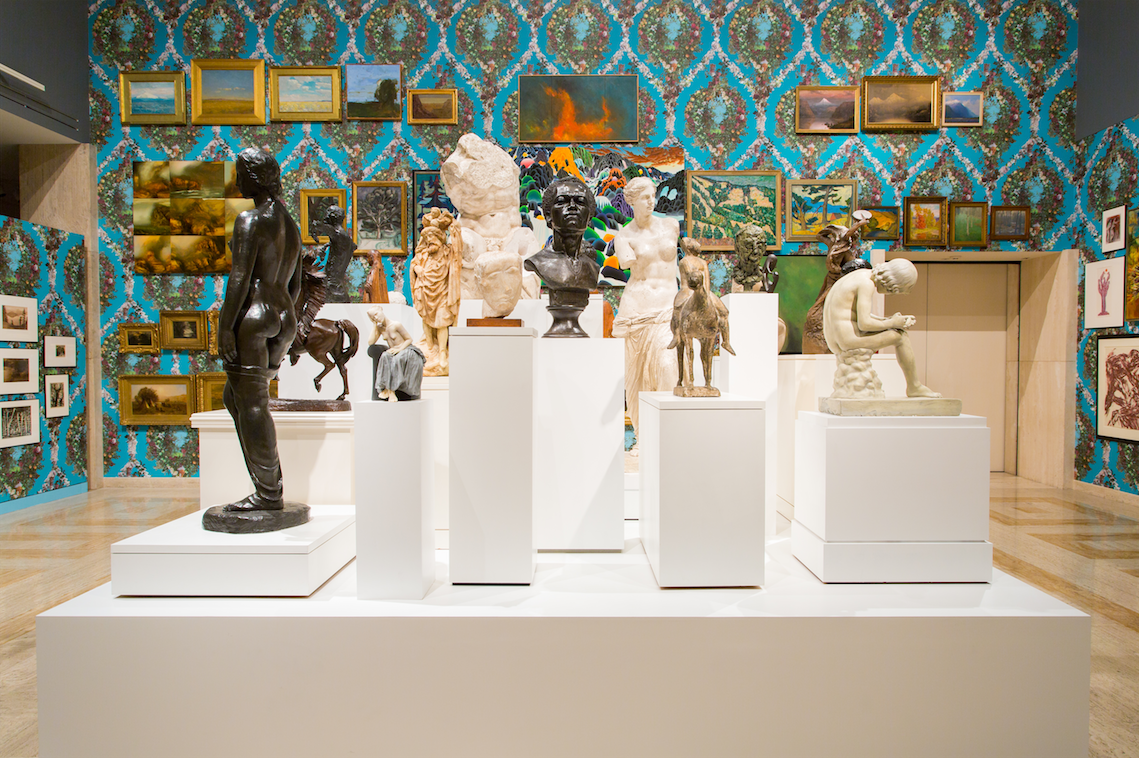
Image credit: David Allen Burns and Austin Young / Fallen Fruit, “Paradise,” documentation image, recontextualized selections from the permanent collection with custom made repeat pattern wallcovering, dimensions variable, commissioned by Portland Art Museum, Porland, Oregon, USA, 2015.
Our artworks are sometimes constructed from reorganizing found objects and objectifying the mythology referents of these objects. Our collective ‘perception of truth’ and how these interpretations relate to found objects… and ultimately how authorship and interpretation of meaning informs identity and place.
Your work has quite a range! From living plants to found objects to collage and to repeat pattern installation design. But all of your work seems to have to do with people and connecting people. What role does identity play in your work?
We believe in complex nuances of the familiar that celebrates people and places. We are focused on the importance of beauty and levity at this time. The asynchronous repeat patterns are carefully constructed and created from diligent on the ground research. We consider them to be portraits of a place -perhaps a city, a neighborhood, or even a garden.
Our work has always been about connecting people. We consider our art to be a form of portraiture -- whether that be a map, or an immersive installation artwork, or a language score. We also recognize that everything we do is a collaboration -- not only in making the artwork as a duo, but also in the activation of its meaning via public engagement and museum archives.
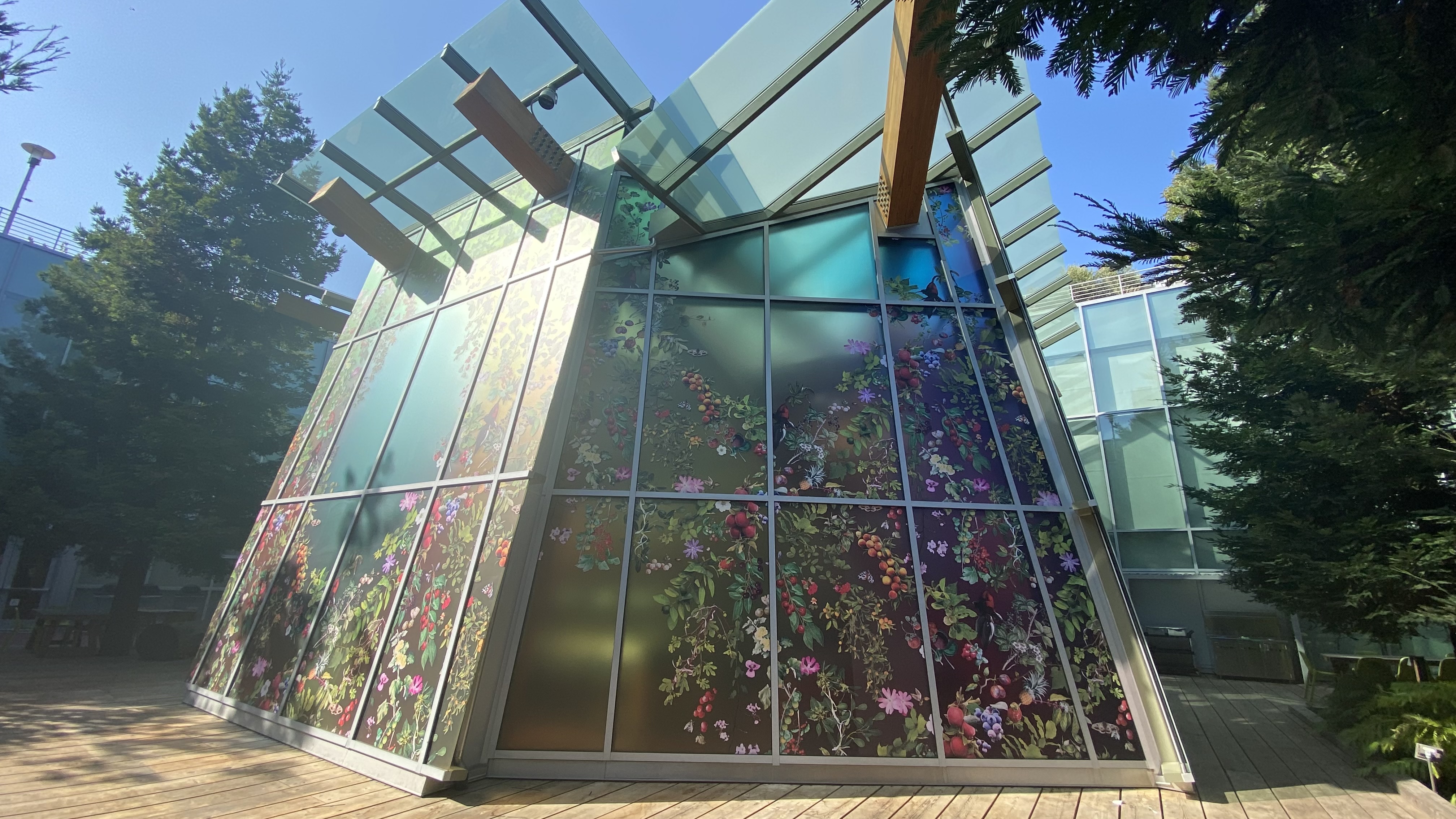
Image credit: David Allen Burns and Austin Young / Fallen Fruit, Event Horizon: recontextualized on 52 panels of glass, custom made a synchronous repeat pattern, archival inks printed onto acrylic substrate, commissioned by META / FACEBOOK as a permanent intervention on architecture by Frank Ghery, 2021.
The visitor of an immersive artwork and their emotional response becomes a part of the artwork. The site also becomes an activated space. We focus on joy and delight and a seek to invoke the sense of the sublime. We get excited about the process of ‘discovery’ in two ways; as part of the research process and also in the maximal carefully considered installation design. We want all types of people to have an opportunity to identify with the artwork and have a sense of familiarity and understanding about their city, histories, and culture.’ And also give them a way to read deeper into the work if they choose.
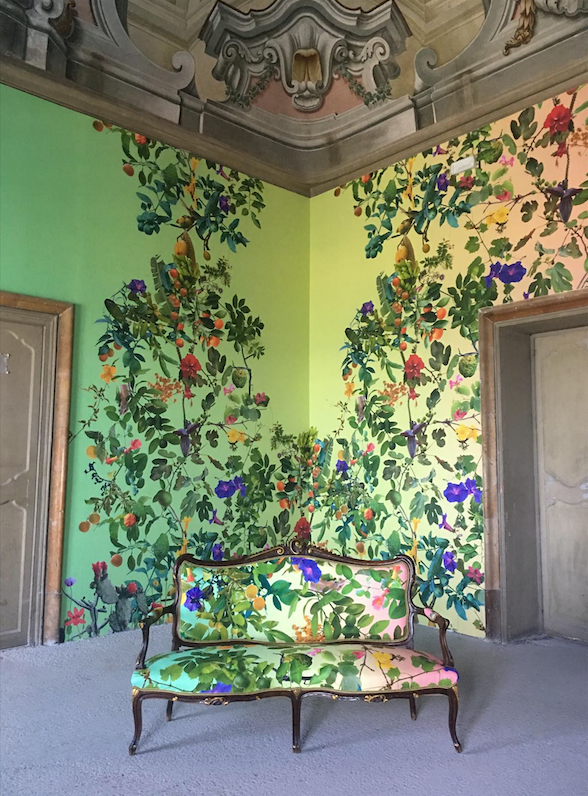
Image credit: David Allen Burns and Austin Young / Fallen Fruit, documentation image with custom refitted vintage sofa, “Teatro del Sole / Theater of the Sun,” asynchronous repeat pattern, archival watercolor inks printed on organic fabric, dimensions variable, commissioned by Manifesta 12, Palermo, Siciily, Italy, 2018.
For much of your work, you are actually in collaboration with local governments as well as institutions and museums. What are some of the rewards and challenges while working with government bodies to create art works?
It is an honor. The best part is always the connections we make with people and the idea that we leave something in a neighborhood that could bear fruit for another 100 years. We feel fortunate to be making artwork. We have been awarded almost 20 permanent works of art in public parks and public rights of way that use fruit bearing trees and shrubs as part of the materials - in New York City, New Orleans, Madrid, Los Angeles, San Diego, and in 2022 upcoming at the Nevada Museum of Art in Reno and more.
All projects have a process and a timeline. “Challenges” and “rewards” we feel are better addressed as “process.” The more people involved and the larger the scale, more agencies are involved for review.
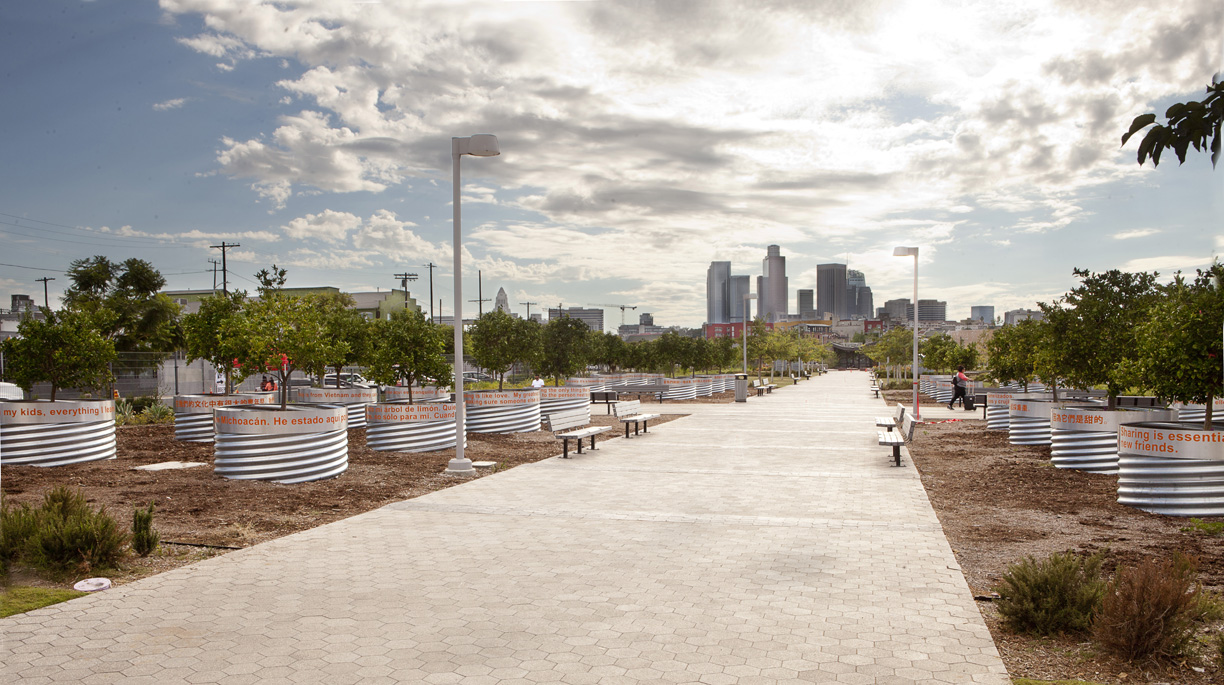
Image credit: David Allen Burns and Austin Young / Fallen Fruit, “Monument to Sharing,” 32 orange trees and 32 line poem created collaboratively with the public, Los Angeles State Historic park, dimensions variable, a Creative Capital Foundation supported project, Los Angeles, California, USA, 2017.
We consider sidewalks in a city and hallways in museums as equitable public spaces. They are the pathways that we travel from place A to place B and they are typically overlooked as places that have meanings. Like the unexpected occasionally epiphenal magic moment -- when the experience of the world resets itself. Seeing a rainbow, running into a friend, remembering something meaningful, noticing something new, etc. We love that place and moment most of all.

Image credit: David Allen Burns and Austin Young / Fallen Fruit, “Promised Land,” asynchronous repeat pattern, archival watercolor inks printed on organic fabric, dimensions variable, commissioned by Tel Aviv University Art Museum for the exhibition PLANET, Tel Aviv, Israel, 2019.

Image credit: David Allen Burns and Austin Young / Fallen Fruit, “Historic Victorville Public Fruit Park,” created with the residents of historic Victorville, in partnership with R.O.O.T., San Bernardino Arts Connection, and the City of Victorville, 2018.
What an important message it is to make magic moments at every corner! What is your advice for artists looking to make an impact beyond traditional artist paths?
At the beginning, people were always trying to define our work as social activism, urban gardening, or a food project. We held our ground and kept presenting and describing the projects as artworks. We are artists making contemporary artwork. If you are starting out, say yes to everything and get into every group exhibition in your category; exhibitions about environment, photography, whatever. Another thing we regularly did was to take opportunities to curate projects inviting other visual artists, performance based artists, and experimental writers to participate with both existing and newly created works. But in the end, you find your own way. There is no magic formula for making it right. We have exhibited in hundreds of group exhibitions and dozens of solo projects at all levels-- local, regional, national, and international. We are actively learning from our research and try to continually push our relationship to materials. We do not actively look for bigger, better, venues -- we are interested in making “good work.”
And this good work has a very distinct style! You have mentioned both surrealism and pop imagery as inspiration for this style. What influences are you responding to in your visual elements?
We are always responding to the present moment - and growing as artists. Considering that we have been making work for 17 + years together - we make video art, photography, fruit parks, we do several participatory projects - some of which have become successful - including Lemonade Stand (our self portrait project) and Fallen Fruit Magazine - (our public magazine collage project) We are always thinking about new things and coming up with new ideas for artworks. It’s a journey. People have fallen in love with our immersive art installations and they have gotten more detailed and complex and better over time.
Pop art and Surrealism have influenced us as artists. We use media like abstraction or collage to relate ideas about the natural world in contemporary moments and in the abstract concepts related to memory and history. Since narrative is subjective, everyone's individual truth makes each person's reaction to the work "right" and we seek to create this common ground for sharing and community.
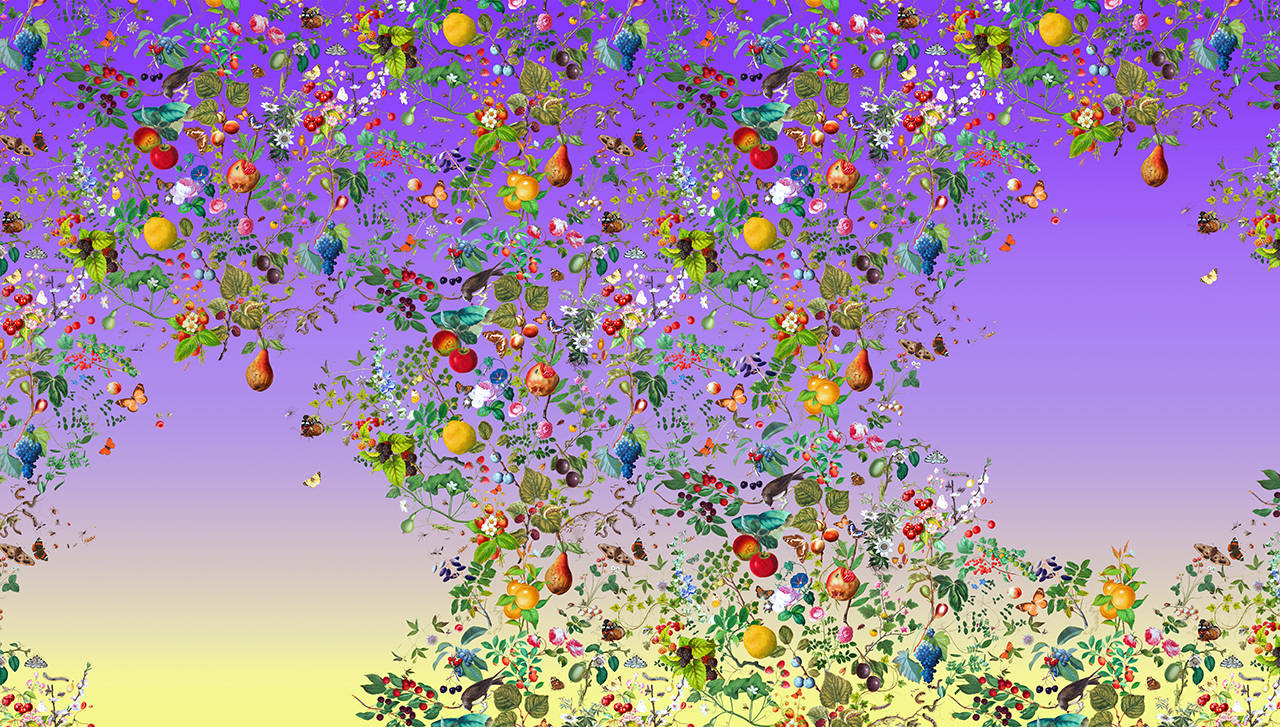
Image credit: David Allen Burns and Austin Young / Fallen Fruit, “Fruits from the Garden and the Field (Purple and Yellow),” commissioned by V&A Museum for the exhibition FOOD: Bigger than the Plate, London, England, 2019.
Collaboration seems to be a really important part of your process. Can you describe your concept of “decentralized collaboration”?
We believe that collaboration is an essential part of culture. In this way, we find that it is essential in contemporary art. Even visiting a museum is a collaboration. Walking in a neighborhood is a collaboration. Sharing an understanding is a collaboration. We, as a people, continually collaborate in passive and intentional ways everyday. We all can’t help it. It’s automatic and an integrated part of everyday life. This is how we as artists explore the depths and capacities for questioning and expand how authorship is created / co-created.
We, as a people, continually collaborate in passive and intentional ways everyday.
A lot of our research is based on observations. Watching people in spaces; walking sidewalks, hanging out in parks, exploring libraries and museums. We listen. And then we listen more carefully to the sounds behind the words, the traffic, the animals, the machines. We listen to the spaces between the words. We watch this way also, looking for the meaning in all of the spaces we are investigating. These spaces are opportunities for unactivated collaborations.
It goes back to the message from Leviticus -- In this case, our interpretation is to leave the harvest of the margins of meanings for the stranger or the passerby. To create beautiful artwork installations for people in the future. To protect the possibilities of learning about something that you may think you already know; to shift canonized meanings and shift understanding to open-ended possibilities found in the future - People may understand these ideas (artworks) differently than we do today over time.
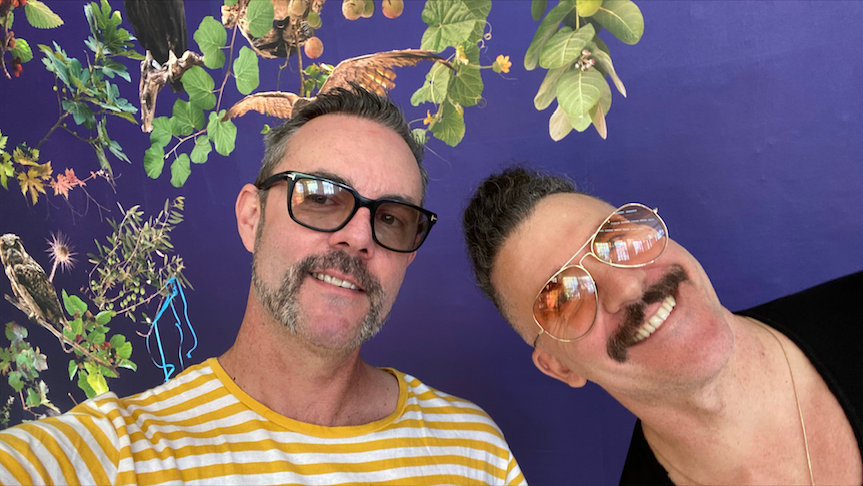
Thank you so much David Burns and Austin Young of Fallen Fruit for such an insightful interview!